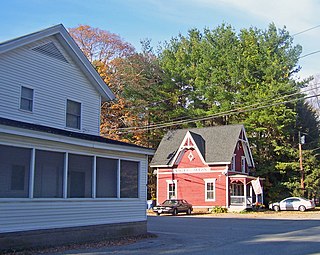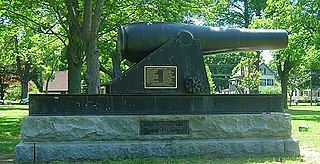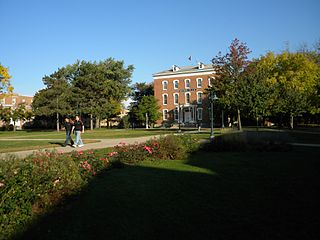
The Fairlie–Poplar Historic District is part of the central business district in downtown Atlanta. It is named for the two streets that cross at its center, northeast-only Fairlie and southeast-only Poplar. Fairlie–Poplar is immediately north of Five Points, the definitive center point and longtime commercial heart of Atlanta. It is roughly bounded on the southwest by Marietta Street, on the southeast by Peachtree Street or Park Place, on the northeast by Luckie Street or Williams Street, and on the northwest by Cone Street or Spring Street. It has smaller city blocks than the rest of the city, and the streets run at a 40° diagonal.

The Boca Chita Key Historic District is a U.S. historic district within the Biscayne National Park in Miami-Dade County, Homestead, Florida. Located on the northwest section of Boca Chita Key, delimited by Biscayne Bay in the north and west and a half ruined stone wall on its southern side, it contains three historic buildings and the Boca Chita Lighthouse. On 1 August 1997, it was listed in the National Register of Historic Places for its architectural, historical and recreational values.

The Sharon Valley Historic District is located around the junction of Kings Hill, Sharon Valley and Sharon Station roads in Sharon, Connecticut, United States. It is a small community that grew up around an iron mining and refining operation during the late 19th century, the first industry in Sharon.

The East Haven Green is the town green of the New England town of East Haven, Connecticut. It is bounded by River Street, Hemingway Avenue, Main Street, and Park Place and is the focal point of the East Haven Green Historic District, listed on the National Register of Historic Places. This area is also part of the commercial business district of the town and contains many two- and three-story brick office buildings that have been constructed within the last ten or fifteen years. Farther to the northwest are a shopping center and high-rise apartment buildings.

College Square Historic District is a nationally recognized historic district located on a bluff north of downtown Davenport, Iowa, United States. It was listed on the National Register of Historic Places in 1983. The district derives it name from two different colleges that were located here in the 19th century.

The Cork Hill District is a nationally recognized historic district located in Davenport, Iowa, United States. It was listed on the National Register of Historic Places in 1984. The historic district covers 18.7-acre (7.6 ha) and stretches from the campus of Palmer College of Chiropractic on the west to the Sacred Heart Cathedral Complex on the east. It is the western half of a neighborhood of the same name. When listed, the district included 12 contributing buildings. It includes Greek Revival, Italianate, and Victorian architecture. The district was covered in a 1982 study of the Davenport Multiple Resource Area and/or its 1983 follow-on.

The Ashby Manor Historic District is located in northwest Des Moines, Iowa, United States. It is a residential area that lies between Beaver Avenue, which is a major north–south artery, on the west and Ashby Park on the east. The historic period of the housing was 1925–1941. The street layout follows a curving pattern, which differentiates it from the grid pattern of the surrounding area. The streets also feature a mature tree canopy. The historic district has 148 properties of which 99 are houses and 49 are garages. Ninety-one properties are considered contributing properties and 57 are noncontributing. It has been listed on the National Register of Historic Places since 1992. It is a part of the Suburban Development in Des Moines Between the World Wars, 1918--1941 MPS.

The Vogel Place Historic District is a nationally recognized historic district located in Ottumwa, Iowa, United States. It was listed on the National Register of Historic Places in 1995. At the time of its nomination it contained 158 resources, which included 101 contributing buildings, six contributing structures, and 51 non-contributing buildings.
Boulder Crescent Place Historic District is a historic area in Colorado Springs, Colorado along West Boulder and Cascade Avenue near the intersection of the two streets. It is a National Register of Historic Places listing and is on the Colorado State Register of Historic Properties.

The Harmon School, at Kirn Rd. and Harmon Rd. near Fallon, Nevada, is a historic building that is listed on the U.S. National Register of Historic Places. The listing included three contributing buildings on 10 acres (4.0 ha). It has served as a school, as a meeting hall, and as a music facility.

The Caddo Valley Academy Complex is a collection of former school buildings in Norman, Arkansas. Set well back from Main Street (Arkansas Highway 8 near the junction of 9th Street and Smokey Hollow Road, the complex includes a two-story fieldstone main building, a smaller single-story home economics building, both located northwest of 9th Street, and a large concrete block gym with a gabled roof, located across 9th Street from the other two. The main school, built in 1924, is an outstanding local example of Craftsman styling; the 1937 home economics building also has Craftsman style; the gym was built in 1951, and is vernacular in style. The school was used until the local schools were consolidated into a new facility in 1971.

Lacey-Keosauqua State Park is located southwest of Keosauqua, Iowa, United States. The park is located along the Des Moines River in Van Buren County. First dedicated in 1921, it is the largest state park in size in Iowa. In 1990, three areas were named nationally recognized historic districts and listed on the National Register of Historic Places.

The Kimballton Commercial District is a nationally recognized historic district located in Kimballton, Iowa, United States. It was listed on the National Register of Historic Places in 1995. At the time of its nomination the district consisted of 34 resources, including 26 contributing buildings and 8 non-contributing buildings. The district covers parts of four blocks of the central business district. The commercial buildings are mostly masonry structures constructed with locally produced bricks and concrete blocks. Eleven of the buildings are frame construction. The buildings are from one to two stories in height, and Late Victorian architectural styles dominate. Because of the hilly terrain, buildings on one side of Main Street have exposed basements, while those on the other side of street are built into the side of a hill. The Bennedsen, Boldt, and Hansen Building is individually listed on the National Register.

The Kimballton West 2nd – West 3rd Street Residential District is a nationally recognized historic district located in Kimballton, Iowa, United States. It was listed on the National Register of Historic Places in 1995. At the time of its nomination the district consisted of 82 resources, including 26 contributing buildings, 11 contributing objects, and 27 non-contributing buildings. The district mostly contains houses and outbuildings associated with the dwellings. They are all frame construction with locally produced brick, clay tile block, or concrete block foundations. Most of the lots are large the house size is a matter of taste or preference. For the most part the houses are 1½-stories, but there are also single-story and two-story structures. Residential architectural styles in the district include Queen Anne, Colonial Revival, and American Craftsman. There are no high style examples in the district. The frame, Gothic Revival, Immanuel Lutheran Church (1904) is located on Second Street, and is individually listed on the National Register.

Old Main is a historic building located on the campus of Wartburg College in Waverly, Iowa, United States. When Wartburg was established in Waverly in 1879 it was a normal school that educated men to teach in Lutheran parochial schools. This building was constructed the following year, which makes it the "first structure associated with German Lutheran higher education in Iowa." It is a three-story brick structure in the vernacular Italianate style. It is five bays wide and four bays deep, and capped with a hipped roof with six small gabled dormers. The building features narrow eaves, a denticular cornice, a paneled frieze, corbelled brick window hoods that are painted white, and cast-iron window sills. When it was built it housed all school functions. The dormitory was in the attic, classrooms doubled as living areas when they were not used for educational purposes, the two teachers were housed on the first floor, and dining/kitchen facilities were located in the basement. It has subsequently housed a variety of the schools functions. The building was listed on the National Register of Historic Places in 1978 as the Wartburg Teachers' Seminary.

The City Hall Park Historic District encompasses one of the central economic, civic, and public spaces of the city of Burlington, Vermont. Centered on City Hall Park, the area's architecture encapsulates the city's development from a frontier town to an urban commercial center. The district was listed on the National Register of Historic Places in 1983.
The Foster Park Historic District is a nationally recognized historic district located in Le Mars, Iowa, United States. It was listed on the National Register of Historic Places in 2008. At the time of its nomination the district consisted of 237 resources, including 166 contributing buildings, one contributing site, 65 non-contributing buildings, one non-contributing structure, and four non-contributing objects. The district comprises ten full blocks and nine half blocks. The historic buildings are houses and their attendant garages, carriage houses, or barns. The houses are between one and 2½-stories and are composed of frame, brick or stucco construction. For the most part they were built between the 1880s and the 1930s. Architectural styles include the revivals styles of the Late Victorian era to the Colonial Revival and American Craftsman styles of the early 20th century. Sioux City architect William L. Steele has several commissions in the district, as do other architects. Foster Park was established on one of the blocks along Central Avenue. It became a focal point for the neighborhood.

The Fenelon Place Residential Historic District is a nationally recognized historic district located in Dubuque, Iowa, United States. It was listed on the National Register of Historic Places in 2015. At the time of its nomination it consisted of 218 resources, which included 171 contributing buildings, two contributing structures, one contributing site, 43 non-contributing buildings, and one non-contributing structure. The residential area that makes up the district is located on a plateau located directly above the Mississippi River Valley. This was the first bluff-top neighborhood in Dubuque that established elevator service. The first Fenelon Place Elevator, listed on the National Register in 1978, was completed in 1894. Early houses on the plateau were small cottages built by lead miners. They were replaced by large houses that were built in two periods. The first period at the end of the 19th century saw houses built in the Italianate, Gothic Revival, Second Empire, and Queen Anne styles. House in the second period in the beginning of the 20th century were largely built in the Classical Revival and Tudor Revival styles.

The College Green Historic District is a nationally recognized historic district located in Iowa City, Iowa, United States. It was listed on the National Register of Historic Places in 1997. At the time of its nomination it consisted of 47 resources, which included 37 contributing buildings, one contributing site, and nine non-contributing buildings. This neighborhood in the central part of the city surrounds a square-block park called College Green, from which it derives its name. The park, which is the contributing site, is found on the earliest maps of Iowa City. While the earliest houses in the district were built in the 1860s, most were constructed between 1890 and 1920. No one architectural style dominates here, but the district contains a variety of styles that were popular in the late 19th and early 20th centuries. This is one of three areas in the city where the fraternities and sororities associated with the University of Iowa are located. The Thomas C. Carson House (1875), which now houses a sorority, is individually listed on the National Register of Historic Places.

Eagar Townsite Historic District is a section of the town of Eagar, Arizona which has been designated a National Historic Place. Sitting on roughly 54 acres, the site contains 37 structures, 21 of which have historical significance. The period of significance is from 1886, the year the townsite was founded, through 1942, which represents the significant period of development of the town. The site was added to the Register on July 23, 1993.




















